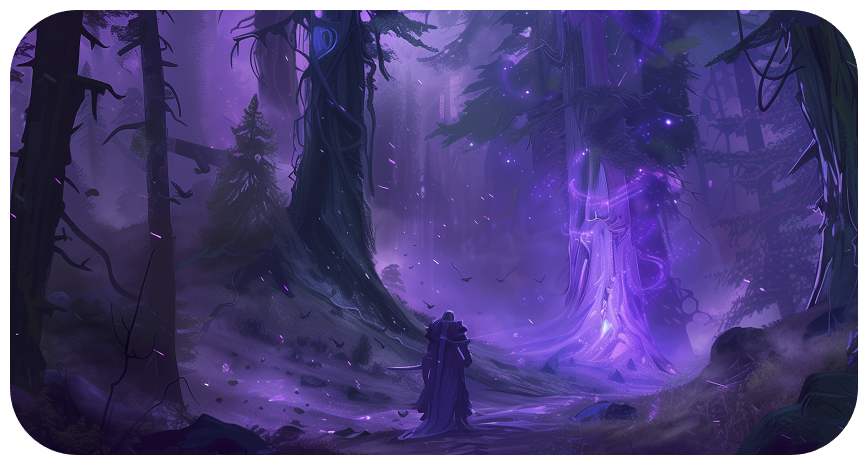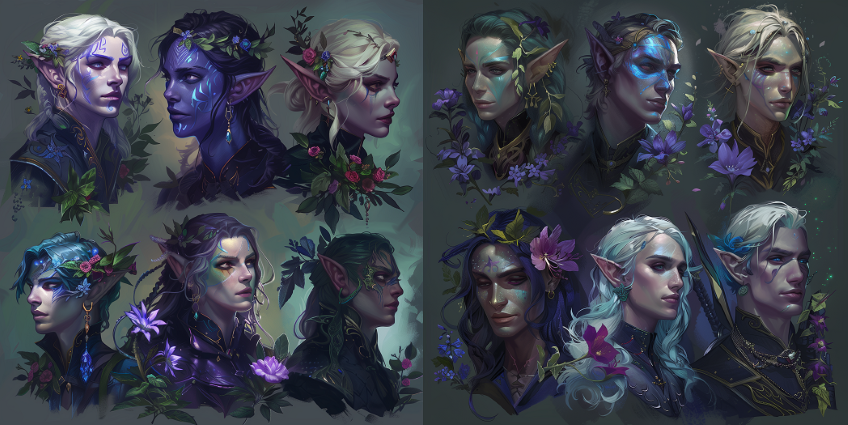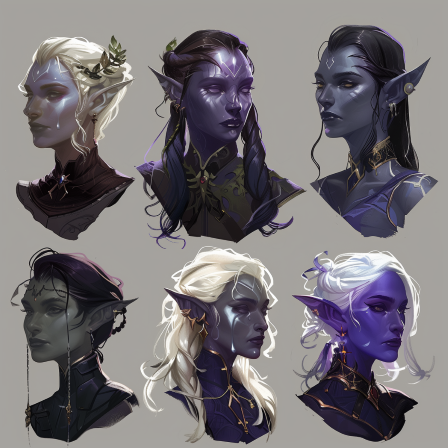Æld'Norai
Introduction
A traditional and spiritual people, elves, or 'Ælves' as they refer to themselves, draw upon fonts of great power to sustain their lives through eternity. You receive a Free Racial Merit for the Draoidh of an Æld'Norai when playing as one.
Fast Facts
- Population: 400,000+
- Lifespan: Indefinite
- Height: Between 5 ft and 8 ft.
- Weight: Between 90 lbs and 500 lbs.
- Limitations: Cannot have children with other races; low fertility.
- Racial Merit: Æld'Norai receive a Free Racial Merit for Draoidh or else a Duty if they never awaken it.
Note: in play, it is also acceptable to write AElf, aelf, etc. in place of the 'Æ/æ' symbol.
Racial Abilities:
Æcturnis
When Ældrassil still drew breath as a dragon, He had long ago achieved the status of Meridian, an Aspect of Grist. He governed Geomena, Sought the Nocturnal, and Embodied Biofluorescent Flora. Further, He was also a Fiadhaich, an Aspect of Draoidh and responsible for the birth of the Draoidh variant, Æcturnis. Because of these factors and then enabled by the bond formed between Himself and the Æld'Norai, they are subsequently able to Awaken Draoidh within themselves, though only within Myrkvior’s inner basin.
- Because of Ældrassil’s nature, an Ælven Draoidh inherits His Æcturnis and functions a little differently than standard Draoidh. Rather than be nourished by the sunlight, an Æcturnis Draoidh's Photosynthesis is fed by the gentle light of the moon, thriving in the night. Further, they must bind themselves to a plant possessing natural biofluorescence before they may bind to anything else. And lastly, they also take after Ældrassil's former nocturnal sleeping patterns.
Lifesight
Æld'Norai with enough contrasting darkness can see the white glow of Saol in all things. The forests at night appear as a lush, brightly lit emerald paradise, as do the underwater caves and their corals, and the subterranean mushroom groves of the Ur'Duun. The undead appear as opaque, black wraiths in their vision, while the living are just as brightly lit with veins of pulsating life; those between life and death such as the Devorare appear dim and grey unless they have recently fed. Animists can also use this gift to see the aggression in a beast, but not a man, and warriors can see the vulnerable arteries of their prey at night. This ability does not function within Ælphyne.
As A People
Biology
The Æld'Norai are lithely built, often androgynous humanoids whose most defining physical features at a glance are their long, pointed ears, stone or jewel toned skin, and vibrant eyes. The Ælves native to the caves tend to be a tad paler and less colorful than their forest counterparts, though the usually subtle differences are harder to tell apart by outsiders.
Aging & Reproduction
Ælves are, in every sense of the word, immortal. Once they reach maturity, the aging process ceases entirely. Despite this, they begin adolescence (10-12 years) and reach maturity (~18) on par to other races, though they won’t treat individuals as proper adults socially until they are at least 50, and even then many older Ælves regard all under 100 to be as children. The elders are even pickier. In turn, their birth rate is incredibly low. Years often pass between individual births even across the entire population of Ælheim.
It is not possible for Æld'Norai to reproduce with any other race.
Sex & Gender
Æld'Norai may be male, female or intersex, with intersex individuals being more common amongst them than among mortal races. Gender presentation of individuals of all sexes varies from masculine to feminine per personal preferences, as one side is not valued more than the other. Due to their naturally more androgynous appearances, many among them find themselves most comfortable somewhere in the middle.
Psychology
Ælves are a secretive and hostile folk when it comes to dealing with outsiders, though amongst themselves they are, in stark contrast, quite open, wanting to foster a close-knit society wherein individuals support one another. As such, many foster a sharp “us vs. them” mentality when it comes to dealing with non-Ælves.
They are inquisitive, curious and wild. Though many are scholarly by nature, their approach is almost never as rigid as the word often applies. Typically employing methods that are unorthodox, their empathy appears to only extend towards one another. And because of those methods, many are also thrill seekers, taking great pleasure in hunting those who wander into– or even too close to– their forests.
Due to their Fae origins and long lives, many also maintain a lot of the Fae’s whimsical aloofness and strange attitudes towards the passing of time. Whether they are patient and meticulous or chaotic and free, ambitious or lazy, careful or reckless, they never appear to be in any sort of rush. This further isolates them from many other races, as they look down upon those who do not share their immortality.
Perhaps due to the influence of the dragon to which they are all bound, many of them are also quite covetous. To name a few examples, this can be highlighted by the collections many possess and the maximalist, art deco nature of their architecture. Caveat emptor: one should never get in between an Ælf and anything they hold dear.
History
One of the oldest races, the tale of the Ælves is a vast tapestry that began far before the dawn of recorded history. However, they, as a people, are secretive and insular– from an outside perspective, it’s hard to parse fact from fiction, legend from reality.
Overview
The Æld'Norai were once a conclave of Sidhe Fae exiled from their homeland, stripped of their Glamour by the Fae Courts. Without a home and their connection to Ælphyne sundered, they fled to the Myrkvior mountain range within which they sought to find an old friend. That friend, now the massive tree of Ældrassil, formed a covenant with these wayward former Fae, binding all of their souls together and restoring their immortality.
In time, the Æld'Norai leaders, the Ældar'i, warred with the progressive, rebel factions of their own kin; those they captured, they flesh-wove into the first humans. Ascended rebel magi who fled and escaped the Ælfblood Cleansing severed their ties to Ældrassil, fostering the Cor'Norai and Jin'Norai.
Origin
While the exact time this happened has been long lost to history, at some point a mischievous band of Galdr-wielding Sidhe Fae came across the Myrkvior mountain range during their search for a suitable ‘grave’ location. An ancient draconic Meridian, a rare friend to these Fae folk, sought a place to slumber. The dragon struggled with wanting to attain final rest and the concept of letting go of himself, so in a bizarre sort of compromise, he decided that he’d become one with the land. These mountains, the group thought, were perfect. With a suitable locale found, the strange menagerie began the process of reshaping the rock before them. They tunneled until they found the mountain’s center point and then began to clear out a basin from within. Once completed, they found themselves surrounded by staggeringly tall walls of rock and collapsed the tunnels they used on their way in. The basin was now only accessible via an incredibly arduous flight in or teleportation.
Working together, the Fae and the dragon warped the dragon’s body, combining it with a sapling brought with them from Elphyne. The dragon, now somewhere between plant and animal, drifted off into a dreamy slumber, blissfully achieving his goal. Bidding him farewell, the Fae then departed, thinking only that those with attachments to him would visit from time to time.
However, the next time this once merry band returned was under circumstances none of them had foreseen. Banished from Elphyne and stripped of their Glamour, these now former Fae fled to the grave site of the old dragon in a desperate bid to commune with the beast. They prayed that their old friend would, in some way, somehow, offer them succor, despite how deeply his soul had been buried.
It took ample expenditure of the magic they still possessed to reach him, but they did, eventually, succeed. Confused by this awakening, the dragon, once informed of their circumstances, formed a pact with these wayward beings, binding all of them together. In turn, they regained their immortality and a modicum more of magical potency– their Glamour, however, was lost for good. And once this rite was completed, the dragon returned to its dreams. Going forward, the former Fae– now dubbing themselves Æld’Norai– would have to forge their own fate, the slumbering dragon being a font of power, not a guide.
Modernity
Modern Ælves are secretive people who are, to most of the world, enigmas. Despite their longevity, not much is known about them simply because they are so tight-lipped about their past and are prone to deliberately weaving tall tales, further obfuscating the truth. The main takeaway outsiders have, generally, is that they are to be feared as much as they are to be admired.
Within their own people, however, their history has been meticulously tracked and stored in vast libraries ever since they were capable of recording it, though few have access to the full breadth of their records. In recent years, they have become more reclusive than ever before as a result of splintering sub factions and the civil war which led to the Ælfblood Cleansing.
Society
Technology
Ælves shirk technology in the traditional sense, instead taking a much more organic approach to progress by embracing their connection to magic. The advancements their mages have wrought over the years rival, and even surpass in some regards, the technology of Dullahan. Due to their long lives and the extensive records kept in Ælheim, they have also skirted the consequences of losing libraries or knowledge dying with individuals, thus granting them a cutting edge above the rest of the world.
- Ælves far from Ældrassil may have varied opinions on technology and its utilization, but most still gravitate towards magical advancement over technological.
Magic
Magic is ubiquitous– with their innate gifts and the influence of Ældrassil’s Grist, the Ælves do not know life without it. Most bias towards magic that is centered around nature, but one could likely find traces of any arcane art if they knew where to look. Though they do have robust safety measures, Ælvenkind readily accepts what unavoidable risks come with their magical endeavors. The pursuit of magic is culturally considered mandatory. While not officially enforced, to abstain, or be unable to, practice magic entirely would result in being socially outcast.
- Even the Ælves who have wandered away from home have a close relationship to magic, with splintering factions still coveting a variety of its practices.
Language
The primary language spoken is Ælvish. Some actively refuse to learn any other tongue, believing theirs to be superior, while others take advantage of their long lifespans to pick up numerous languages either for fun or practical purposes. Regardless, no specific additional language is particularly common.
Naming Convention & Titles
Æld'Norai names are listed as follows:
- Title, Forename fyn’Surname Epithet
If an Æld’Norai lacks any special title, then their social caste will be used within Ælheim instead.
The forename is a standard given name.
Surname is one's family name.
Lastly, the epithet is more of a tradition than anything, and is meant to pay homage to the Æld’Norai’s roots as faefolk.
Examples:
- Dommær, Æstrid fyn’Åström Isolt
- Jegær, Nyyrikki fyn’Bergvist Amyas
- Odoln’i, Vrítræ fyn’Byrne Eunæ
- Sindar'i, Volund fyn’Kjær Valan
*It is common to use the ‘æ’ symbol in place of other vowels. *The forename is typically going to be of old Norse origin, though names of Scandinavian origin in general work. Slavic or Bavarian nomenclature, as well as Latin and Greek, would not be unwelcome as an ‘ælvish’ name. *The surname ought to be old Norse, Celtic, Scandinavian, Slavic, Bavarian, Latin or Greek or any combination thereof. In-universe location names are also acceptable. *The epithet should be of Celtic origin.
Notable Settlements
Ælheim
The overwhelming majority of modern Æld'Norai live nestled in and around the Myrkvior mountain range in the ancient, arcane nation of Ælheim. The capital of which is Ælfiríki, an arboreal paradise built into and around the great tree, Ældrassil. The mountains themselves play host to the city of shadows, Sværlys, as well as myriad other settlements sprinkled throughout Myrkvior's cave systems.
For in depth information on Ælheim, see the codex located in the forums.
Related Articles
Antarok Handbook
|
Rules of Play |
Terms of Use · Rules of Play · Starting Guide · Experience · Merits · Skills · Skill List |
|
Seasonal Points · NPCs · Duty · Formations · Dungeoneering · Challenge Rating |
|
|
Threads · Calendar · Living Standards · Travel · Rebirth |
|
|
Lore |
|
|
Arcana · Arcana List · Religion · Planes · Metaphor · Alkahest |
|
|
Races |
Races · Mongrels · Bloodlines |
| Mæn [ Human · Æld'Norai · Cor'Norai · Jin'Norai · Dwarf · Gnome ] | |
| Faefolk [ Dragon · Kobold · Inari · Sidhe · Dryad · Pixie · Boggart · Satyr ] | |
| Vokhai [ Orc · Trow · Goblin · Gnoll · Najda ] | |
|
Sofontti [ Doggi · Wolvetti · Foxti · Haretti · Rodentti Lynxetti · Mustetti · Bearetti · Cervitti · Porcitti ] |
|
|
Cambion [ Rakshasa · Djinn · Aeon · Aarakora · Mithræ · Knocker Abyssal · Aranexi · Leshy · Onryo · Daemon · Haemora ] |
|
|
Undead [ Draugr · Ghost · Wisp · Endless · Dracolych ] |
Forum Links [ Back to Antarok · Character Sheets · Ælheim · Support Forum ]


